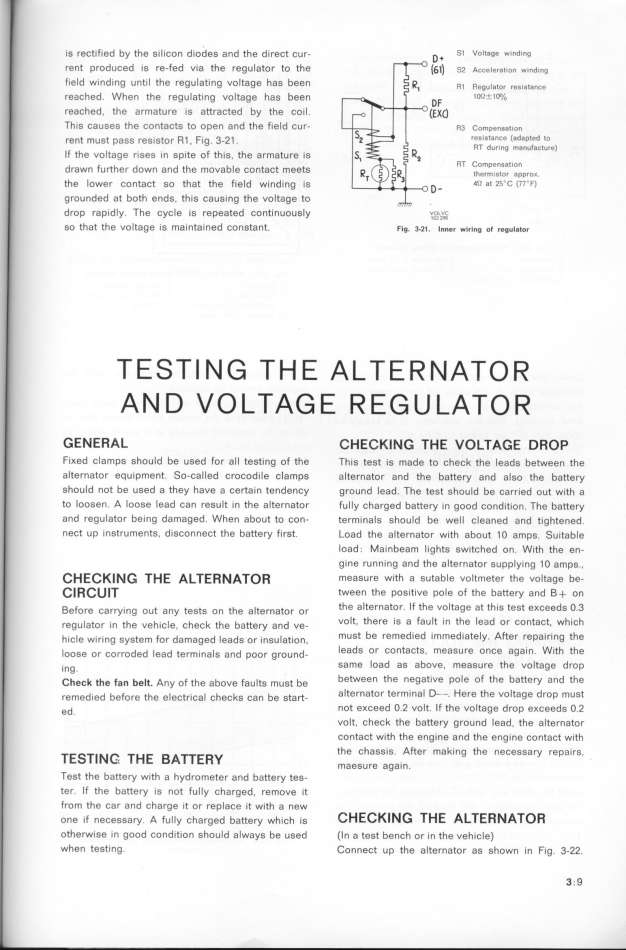 |

|
 |


Begin OCR Text:
_A
e_
__
_ jv
_o
__ _
_A
H_
E E
A_
_ _E
E_
_u
__
AA
__
oo
__
ig reštified by the gi_išo, diodeg a,d the direšt šur S1 Volt6ge winding
=
D+
rent produced is re-fed via the regulator to the (6l) s2 Acce_e,a_ion winding
fieId Winding Until the regUlating voltage haS been __ F3,g,_,_o, ,,,_,,_,,_e
reašhed Whe, the ,egu_aEURi,g voitage hag bee, 1OC_t1_X_
_ DF
reached. the armature is attracted by the coil. (Ex_
This causes the contacts to open and the field cur_ R3 Compensa_ion
re,t mugt pagg reg__gtor __ F_ig 3___ ,eSiStanCe (ad6pted lo
' ' ' RT during manufacture)
If the voltage rises in spite of this, the armature is
F h d h bi EUR RT Compensation
drawn U_ er oWn and t e moVa e ContaCt mee S __ _ _
e,_IS OJ 6PP,O__
the _ower šo,EURašt go that the fie_d wi,di,g ig D_ 4__ at 25DC (77OF)
grounded at both ends, this causing the voltage to .
drop rapidly. The cycle is repeated continuously ;,o,L,v,c,
so that the voltage is maintained constant. Fi$. 3-_1. inner w_ring o_ reguia_or
GE NERAL CH ECKl NG TH E VOLTAGE DROP
Fi_ed cIamps should be used for all testing of the This test is made to check the leads between the
alternator equipment. So-caIled crocodiIe clamps alternator and the batfey and also the battery
should not be used a they have a certain tendency ground lead. The test should be carried out with a
to loosen. A loose lead can result in the alternator fully charged battery in good condifion. The battery
and regulator being damaged. When about to con- terminals should be well cleaned and tightened.
nect up instruments, disconnect the battery first. Load the alternator with about 1 O amps. Suitable
Ioad . Mainbeam lights switched on. With the en_
gine running and the alternator supplying 1 O amps.,
CH ECKl N G TH E ALTERNATOR measure with a sutable voltmeter the voltage be-
C_RCUlT tween the Positive pole of the battery and B + on
_ F h _ the alternator If the voltage at thie test eKceeds O 3
g ore Caffylng OUt any teStS On t e a tef,atOf Or ' '
_ h h i h k h b d volt there is a fault in the lead or contact which
fegu ator In t e Ve _C e. C eC t e attefy a, Ve= ' '
h_ _ _ _ t F d d _ d _ _ EUR_ mUSt be femedied immediately After ,epai,ing the
iš e Wlflng SyS em of amage ea g or InSU a lO,, _
_ d d _ d _ d d leads or contacts measure once again With the
OOSe Of COrrO e ea terml,a S an pOOr ▀rOUn - ' '
i.,g same Ioad as above, measure the voltage drop
__' _ h _ b _ A F h b F _ b between the negative pole of the battery and the
eš t e an e t. ny O t e a OVe aU tg mUgt e
remed__ed beFore the eieštr_išai šheškg ša, be gEURa__ altefnatof terminal D-. Here the voltage dfop mUSt
ed not eKceed O.2 volt. If the voltage drop eKceeds O.2
' volt, check the battey ground lead. the alternator
contact with the engine and the engine contact with
the chassis. After making the necessary repairs.
TESTIMC TH E BATTERY m,,,,,, ,g,.,,
Test the battey with a hydrometer and battery tes- '
ter. If the battery is not fully charged. remove it
from the car and charge it or replace it with a new eC G R
o,e iF nešeggary. A Fu__y charged battery whišh ig CH Kl N THE ALTER NATO
otherwige in good condition should alwaye be used (ln a test bench or in the vehicle)
when tesfing. Connect up the alternator as shown in Fig. 3-22.
3 . 9
|

